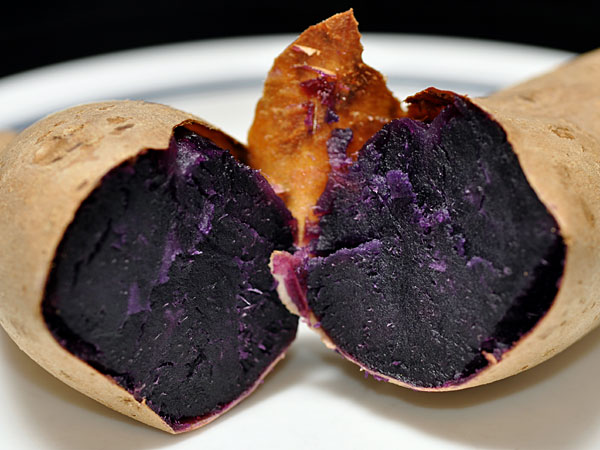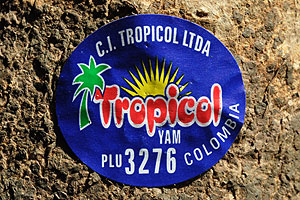


We found a recipe and made some cupcakes. We were going to share some, and it occurred to me that someone might ask if those purple yams were really yams, or were they sweet potatoes, and what's the difference anyway.
I determined that these are actually purple sweet potatoes, murasaki imo in Japanese, also called Okinawa sweet potatoes — not ube. (The cupcakes were quite tasty anyway!)
I'm not going to tell anyone what to call their food. "Yam" and "sweet potato" are pretty much interchangeable in the U.S., but if you want to make a distinction based on botany, read on. There are many "yam vs. sweet potato" explanations online, but I didn't find any that seemed completely adequate. So here's mine, with potatoes thrown in for good measure.
 | |||
| Common name | Potato Irish potato White potato Jaga-imo | Sweet potato Yam Batata Kumara Satsuma-imo | Yam Ñame Kandmool Kosu Yama-imo |
|---|---|---|---|
| In the market | They look like potatoes, they're called potatoes. No confusion here. | They're just as likely to be called yams as sweet potatoes, but whatever they're called, they look like sweet potatoes, and that's what they are. | They don't look like potatoes or sweet potatoes. At the Newark Farmers Market (the only place I've seen them for sale) the signs above them say "name", but some have stickers that say "yam". |
| Scientific name | Solanum tuberosum | Ipopmoea batatas | Dioscorea spp. (see Wikipedia for species) |
| Family | Solanaceae (Nightshade family) | Convolvulaceae (Morning-glory family) | Dioscoreaceae (Yam family) |
| Edible part | Stem tuber | Root tuber | Root tuber |
| Shape & size | Rounded; mostly under a pound. | Tapered at both ends; often over a pound, especially those called yams. | Cylindrical, or irregularly lobed; mostly over a pound, up to over 100 pounds. The yam in the photo above is 10" long and 2.5 pounds. |
| Skin | Smooth or slightly rough, in colors from almost white to purple, but typically brown; edible. | Not as smooth as potato skin, in colors from tan (most common) to purple; edible, but most prefer them peeled. | Brown and rough (some say scaly or bark-like); inedible. |
| Flesh | Varies in color, but is typically white. | White to purple, but is typically pale yellow or orange. | White, yellow, or pale purple. |
| Origin | Southern Peru Domesticated 7-10,000 years ago | Central or South America Domesticated at least 5,000 years ago | Africa and Asia Cultivated 10,000 years ago |
| Nutrients | nutritiondata.com
| nutritiondata.com
| nutritiondata.com
|
| PLU |
|
| 
|
| Links |
| ||
| Delaware wildflowers | Several Solanum species can be found in Delaware. As far as I know, none are edible. | Several Ipomoea species can be found in Delaware. I. pandurata is reported to have edible roots! | Two Dioscorea species can be found in Delaware. D. polystachya (D. batatas, D. oppositifolia) is reportedly edible. |